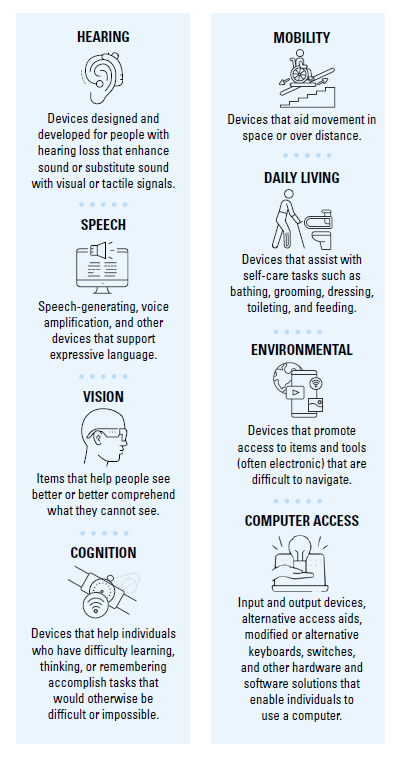Navigating Assistive Technology
Categories: Living with Brain Injury
“For people without disabilities, technology makes things easier; for people with disabilities, technology makes things possible.” — IBM training manual, 1991
by David Baker
There are many ways to describe the profound impact technology has in the lives of people with disabilities. None is more succinct or prophetic than the quote above.
As technology has advanced, our lives have benefitted; many would argue that they are more comfortable, safer, and even more fun. By text, voice, and video we communicate with family, friends, and colleagues. We bank, order groceries, and visit the doctor from the comfort of our homes. At all hours of the day, we Tweet, post, stream, and “like.” We monitor our health, track our steps, and know from across the globe if we left the garage door open. Technology has made things easier.
For people with disabilities, including many with brain injury, technology has helped restore or improve function and compensate for limitations. It has enabled them to care for themselves and their families, to work, to learn, to access information, and to participate fully in community life. In other words, it has made things possible.
The term most often used to describe technology for people with disabilities is “assistive technology” (AT). AT is an umbrella term that refers to both devices and related services. Wheelchairs and walkers, hearing aids, screen enlargement software, environmental controls, and aids to daily living that make tasks such as cooking, dressing, and grooming easier are a few examples of the many assistive devices available. Assistive technology services are those activities that directly assist an individual in the selection, acquisition, or use of an assistive technology device. Evaluating an individual for an appropriate device, the provision of device training, and funding assistance are examples.
The effects of brain injury are complex and their impact varies from person to person. What was once easy may now prove difficult due to changes in an individual’s physical, cognitive, sensory, communicative, or behavioral capabilities. The challenges that present themselves provide insight as to where the incorporation of assistive technology might be useful in helping to reduce the consequences of an individual’s changed abilities. The vast array of assistive technology devices available may be overwhelming to individuals new to the field.
As more mainstream companies build assistive features into their devices (e.g., smartphones and tablets) and more mainstream products (e.g., home automation) have applications that can positively benefit people with disabilities, the sense of being overwhelmed only increases. The availability of so many options, though, is on the whole a good situation.
To make the exploration of assistive technology easier, an important first step is to understand the field is often divided into categories or product families, that there is a continuum of assistive technology, and that it’s important to match features to products.
Assistive Technology Continuum
Assistive technology devices range in complexity and are often divided between low-tech, mid- tech, and high-tech. Low-tech devices are those that don’t require much training, are inexpensive, and do not have complex or mechanical features. Mid-tech devices may require more training, usually are digital, and may require batteries and a power source. High-tech devices are typically computer based, likely to have advanced features, require considerable training, and can be tailored to the specific needs of the individual. Assistive devices do not have to be expensive or complex to be the right match for an individual. AT professionals will work along the continuum from low-tech to high-tech based on the needs of the individual.
Assistive Technology Feature Matching
Feature matching is the final pillar in getting started with assistive technology. Feature matching is the process by which the elements of a device align to the user’s needs based on their range of abilities. Too often, device abandonment occurs shortly after purchase because it was selected based on elements other than what the user needs. An added benefit to feature matching is that device names don’t need to be remembered, just the aspects that will make them effective for the user.
The AT categories, AT continuum, and importance of feature matching provide a solid foundation on which to begin your personal pursuit of AT solutions. Set a simple goal. Select a task that presents a challenge that you wish to do easier or independently. Identify the AT category. List out the features the device needs to have and begin your exploration.
Many great online resources are available to help. The AT3Center’s Explore AT is a clearinghouse for information and resources on many different assistive technologies. Find it at at3center.net/explore-at. It will help you identify AT devices and services in the environments of education, employment, and community living for all ages and functional abilities. In addition, there is a federally funded Assistive Technology Act Program located in each state. The Tech Act Programs provide a range of services from information and assistance to demonstrations, from device loans to funding assistance. Services vary by state. Access it at at3center.net/state-at-programs.
This article originally appeared in Volume 16, Issue 2 of THE Challenge! published in 2022.

